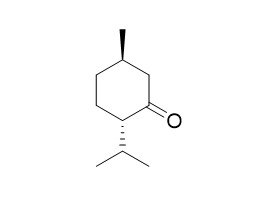(-)-Menthone
(-)-Menthone can significantly increase the transdermal penetration of the hydrophilic drug caffeine and the polar steroid hydrocortisone.
Inquire / Order:
manager@chemfaces.com
Technical Inquiries:
service@chemfaces.com
Tel:
+86-27-84237783
Fax:
+86-27-84254680
Address:
1 Building, No. 83, CheCheng Rd., Wuhan Economic and Technological Development Zone, Wuhan, Hubei 430056, PRC
Providing storage is as stated on the product vial and the vial is kept tightly sealed, the product can be stored for up to
24 months(2-8C).
Wherever possible, you should prepare and use solutions on the same day. However, if you need to make up stock solutions in advance, we recommend that you store the solution as aliquots in tightly sealed vials at -20C. Generally, these will be useable for up to two weeks. Before use, and prior to opening the vial we recommend that you allow your product to equilibrate to room temperature for at least 1 hour.
Need more advice on solubility, usage and handling? Please email to: service@chemfaces.com
The packaging of the product may have turned upside down during transportation, resulting in the natural compounds adhering to the neck or cap of the vial. take the vial out of its packaging and gently shake to let the compounds fall to the bottom of the vial. for liquid products, centrifuge at 200-500 RPM to gather the liquid at the bottom of the vial. try to avoid loss or contamination during handling.
Applied Biological Chemistry2022, 71:s13765-022-00743-5.
Evid Based Complement Alternat Med.2017, 2017:7383104
Biomed Sci Letters.2020, 26:319-326
Food Chem.2019, 279:80-87
Anal Bioanal Chem. 2016, 408(15)
J Chromatogr A.2017, 1518:46-58
BMC Complement Altern Med.2018, 18(1):303
Foods.2023, 12(6):1227.
Rec. Nat. Prod.2024, 18:4,405-418.
Cancers (Basel).2023, 15(1):293.
Related and Featured Products
Int. J. Mol. Sci. 2011, 12(10), 6635-6644.
Quantitative Comparative Analysis of the Bio-Active and Toxic Constituents of Leaves and Spikes of Schizonepeta tenuifolia at Different Harvesting Times.[Reference:
WebLink]
METHODS AND RESULTS:
A GC-MS-Selected Ion Monitoring (SIM) detection method was developed for simultaneous determination of four monoterpenes: (-)-Menthone, (+)-pulegone, (-)-limonene and (+)-menthofuran as the main bio-active and toxic constituents, and four other main compounds in the volatile oils of Schizonepeta tenuifolia (ST) leaves and spikes at different harvesting times. The results showed that the method was simple, sensitive and reproducible, and that harvesting time was a possible key factor in influencing the quality of ST leaves, but not its spikes.
CONCLUSIONS:
The research might be helpful for determining the harvesting time of ST samples and establishing a validated method for the quality control of ST volatile oil and other relative products.
Drug Development Communications, 1999, 25(8):905-915.
Influence of Drug Lipophilicity on Terpenes as Transdermal Penetration Enhancers.[Reference:
WebLink]
METHODS AND RESULTS:
Percutaneous absorption-enhancing effects on the skin of hairless mice of 11 monoterpenes [1, (+)-limonene; 2, (-)-Menthone; 3, (+)-terpinen-4-ol; 4, α-terpineol; 5, 1,8-cineole; 6, (+)-carvone; 7, (−)-verbenone; 8, (−)-fenchone; 9, p-cymene; 10, (+)-neomenthol; and 11, geraniol] were investigated using three different model drugs (caffeine, hydrocortisone, triamcinolone acetonide [TA]) with varying lipophilicities. Terpenes were applied at 0.4 M in propylene glycol (PG) to mouse skin. The model drugs were applied as suspensions in PG 1 hr following enhancer pretreatment. The combination of terpenes in PG provided significant enhancement of the permeation of caffeine through mouse skin. The most active compounds 10 and 11 increased permeation by between 13-fold and 16-fold. The terpenes also enhanced the delivery of hydrocortisone, but not to as great an extent. The most active compounds 3 and 4 increased permeation between 3.9-fold and 5-fold. The compounds examined did not significantly increase the delivery of TA. The most active compound 4 only increased delivery 2.5-fold, while the next most active compound 6 only increased delivery 1.7-fold.
CONCLUSIONS:
Overall, these results indicate that the combination of terpenes with PG can significantly increase the transdermal penetration of the hydrophilic drug caffeine and the polar steroid hydrocortisone.
Phytochemistry, 1980, 19(10):2103-2110.
Chemogenetic evidence supporting multiple allele control of the biosynthesis of (−)-menthone and (+)-isomenthone stereoisomers in Mentha species.[Reference:
WebLink]
The essential oils of certain Mentha species and chemotypes have proportions of (-)-Menthone and (+)-isomenthone which differ but show a high degree of heritability in clonal propagation. Oil from an F2 individual (69–296), selected from numerous 4n M.
longifolia (4n = 48) × M. crispa (2n = 48) hybrids for high isomenthone content, had 41.3% isomenthone; the associated but seldom observed alcohols, 1.6% isomenthol, 10.3% neoiso-menthol; and 13% of their esters; in contrast to 8% menthone with 0.1% menthol, 5.0% neo-menthol, and 1.7% esters. Self-pollination of strain 69–296 gave a 3:1 ratio of high isomenthone: high menthone.
METHODS AND RESULTS:
Crosses with a true breeding high menthone plant having 80% menthone and 3.2% isomenthone gave a 1:1 ratio of the parental phenotypes by GLC analyses and herbage odor. This and data from high isomenthone and high menthone crosses with tester strains lead us to postulate the involvement of a single locus having multiple alleles with true breeding menthone having the genotype Ps Ps, true breeding isomenthone Pr Pr, 69–296 Pr Ps, and high pulegone pp. The Pr allele is not completely dominant over the Ps allele in 69–296 as about 18% of the total ketone derived from pulegone is menthone. Both are dominant over the recessive allele p that largely prevents menthone development.
CONCLUSIONS:
The quantitative amounts of the two isomers are believed to be controlled by the six combinations of the three alleles in a diploid species with graded effects obtained in the more complex genotypes possible in double diploid and octoploid species. 69–296 has (−)-piperitone even though (+)-piperitone is believed to be the common isomer in Mentha.



